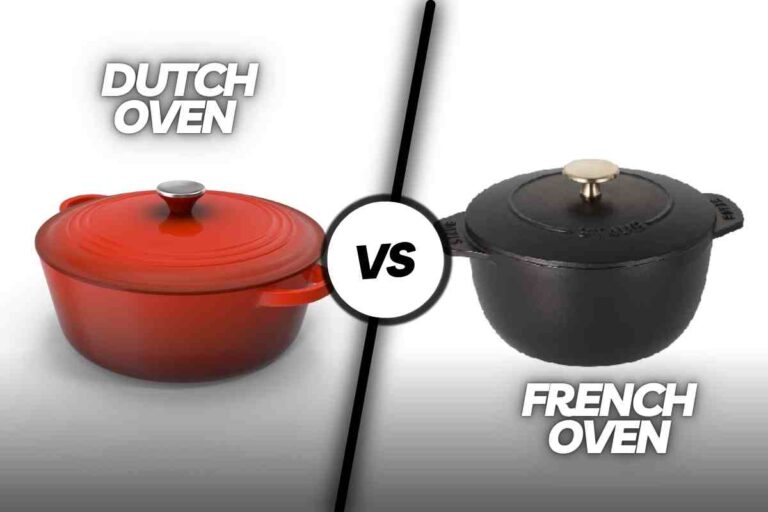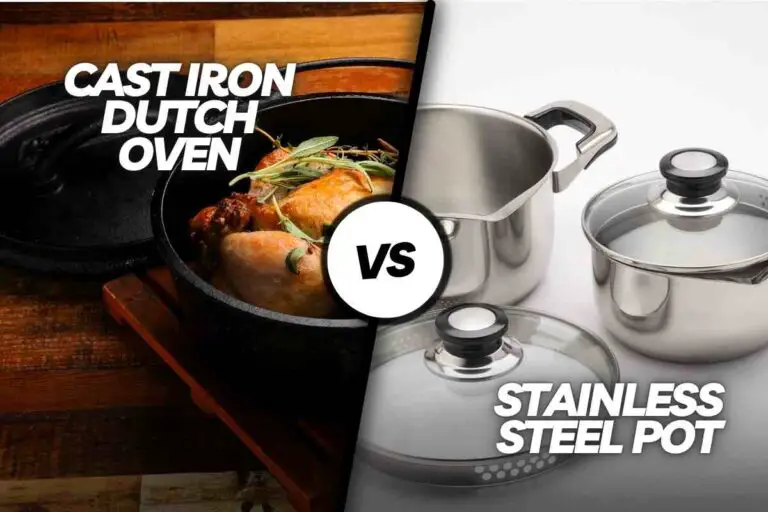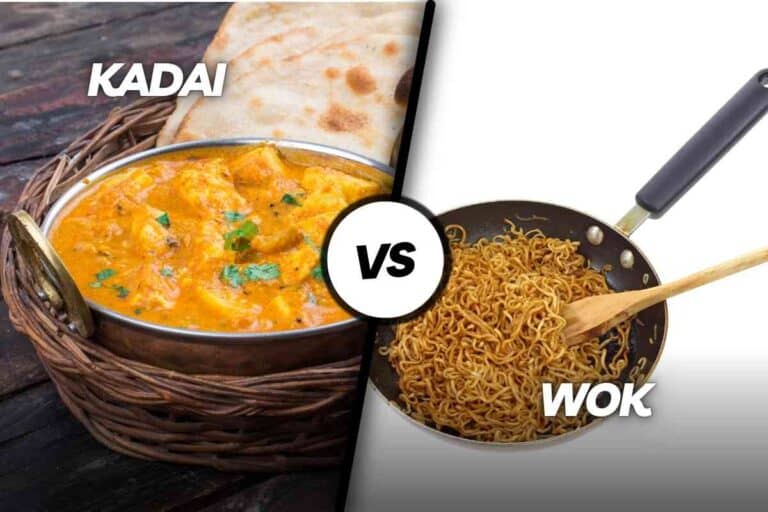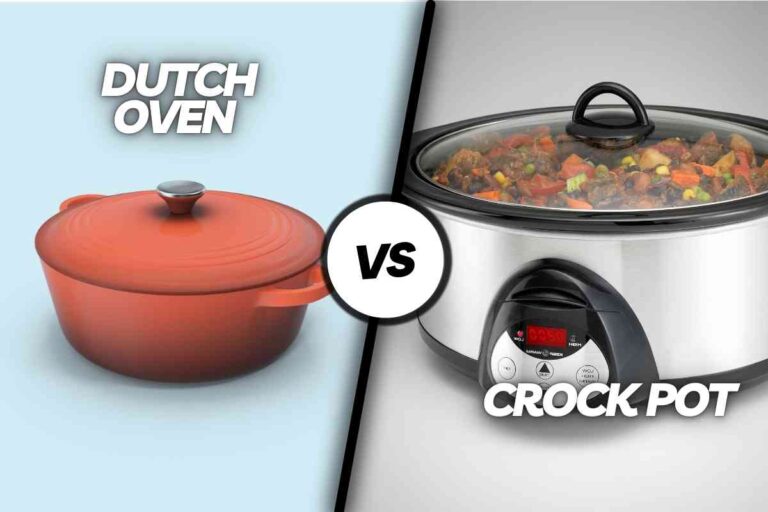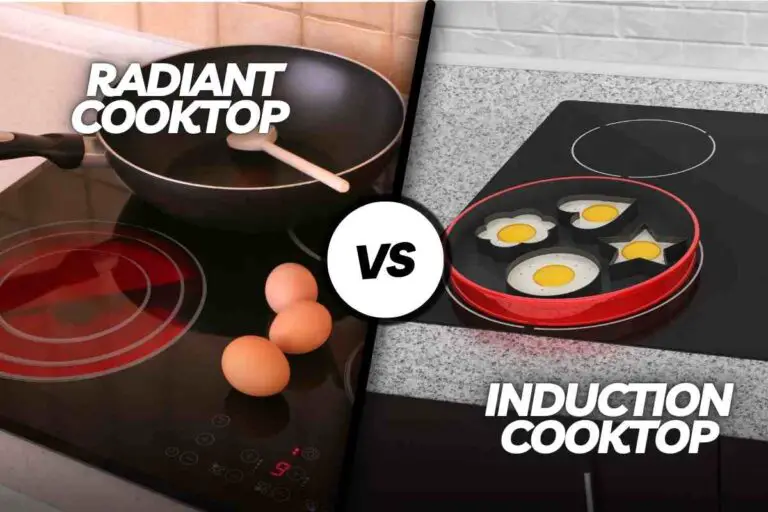7 Key Differences: Wok Vs Cast Iron Skillet
The main difference between a Cast Iron Wok and a Cast Iron Skillet lies in their design and intended use. A Cast Iron Wok is round-bottomed with sloping sides, making it ideal for stir-frying, deep-frying, searing, and boiling. On the other hand, a Cast Iron Skillet is flat-bottomed with straight sides, suitable for frying, searing, baking, and broiling.
A Wok features high sides that provide more surface area, making it ideal for stir-frying and preventing food from spilling onto the stove during stirring.
High-quality Woks are typically made of either carbon steel or cast iron, with carbon steel being the preferred material due to its resilience, lightweight nature, and faster heat-up and cooldown properties.
While both Woks and Cast Iron Skillets can serve similar purposes, carbon steel is more popular for woks, even though historically, woks were originally made of cast iron.
7 Key Differences: Wok Vs Cast Iron Skillet
| Characteristic | Wok (Cast Iron) | Cast Iron Skillet |
|---|---|---|
| Bottom Shape | Round-bottomed | Flat-bottomed |
| Side Shape | Sloping sides | Straight sides |
| Primary Uses | Stir-frying, deep-frying, searing, boiling | Frying, searing, baking, broiling |
| Food Movement | Facilitates easy food movement | Suitable for various dishes, no specialized movement |
| Splatter Control | Contains splatter during high-heat cooking | Limited splatter control |
| Versatility | Great for Asian-style cooking methods | Versatile for various cooking styles |
| Typical Dishes | Asian stir-fries, deep-fried dishes | Pancakes, steaks, grilled cheese, various dishes |
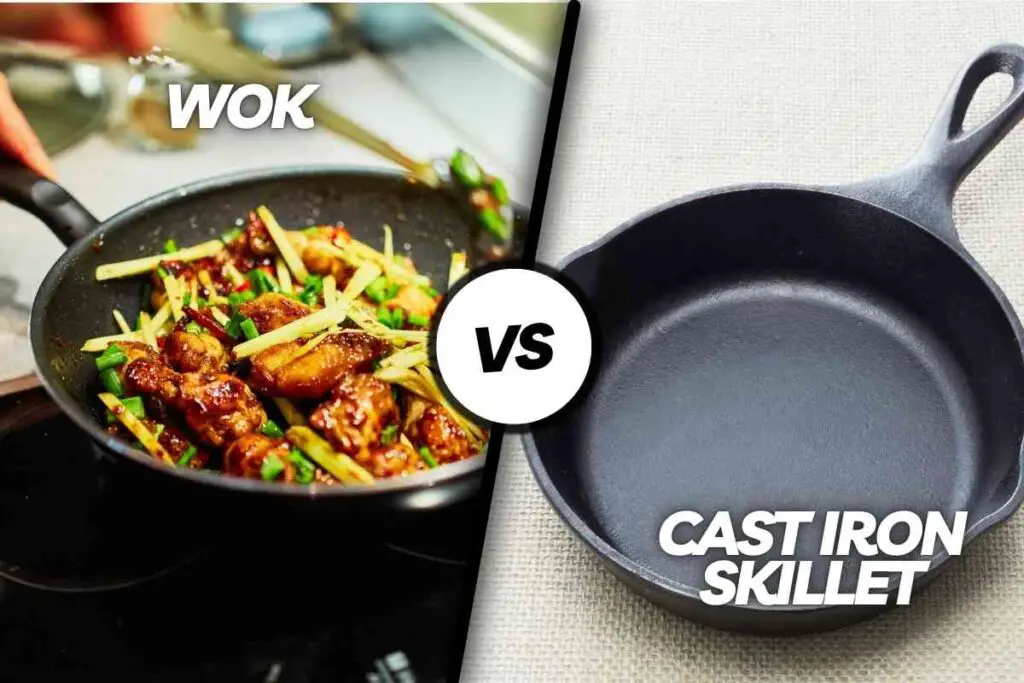
Wok Vs Cast Iron Skillet: What’s the Difference
Cast Iron Wok Vs Cast Iron Skillet: Both wok cast iron and cast iron skillet are made of cast iron, which makes them durable and ideal for high-heat cooking. However, they have distinct differences in terms of shape and usage:
Cast iron wok
It is round-bottomed and has sloping sides. It is used for stir-frying, deep-frying, searing, and boiling. Its shape allows for food to be moved around easily and its sides contain splatter.
Cast iron skillet
It is flat-bottomed and has straight sides. It is used for frying, searing, baking, and broiling. Its flat bottom makes it easy to cook a variety of dishes, including pancakes and grilled cheese.
Carbon steel woks are less brittle
Carbon steel woks have many benefits, including the ability to withstand high heat. This makes them the preferred choice for many seasoned Asian chefs.
As an added bonus, they are less expensive, too. Carbon steel woks are easy to clean and able to handle high temperatures.
Carbon steel is a versatile material, allowing you to use it for all your cooking needs. It can withstand high temperatures without warping or scratching.
It also doesn’t need special treatment, making it easy to clean. You can use it in the oven or on the stovetop.
Carbon steel woks are less bribrittle than cast iron skillets. They also heat evenly and quickly. Carbon steel woks are much less expensive than cast iron skillets.
They are generally suitable for induction or gas burners. If you season them properly, they will have a nonstick surface. Cast iron woks are heavier and thicker than carbon steel ones.
Non-stick copper wok helps release food with ease
A non-stick copper wok has an aluminum core and is great for circulating heat, allowing food to release easily.
It also has a large convex surface, which makes cleaning easy. Its 12-inch size is lightweight and comes with a riveted handle.
It also has an extra-thick non-stick coating. This means it’s dishwasher safe, although the manufacturer advises hand washing. You’ll also want to avoid using utensils that might scratch the coating.
This model comes with a lifetime warranty. If you’re looking for a non-stick wok in a budget-friendly price range, consider the Cook N Home 12-inch non-stick wok, which has a stylish green exterior and speckled interior.
The All-Clad wok is dishwasher-safe, and the company recommends using Barkeeper’s Friend to clean any stuck-on food.
The All-Clad wok also boasts a limited lifetime warranty. The company says the wok has a chef’s pan heating style and offers fast heat distribution.
However, the wok can get heavy when fully loaded. Before buying a wok, consider its size, capacity, price, and material.
Stainless steel woks transmit heat quickly
When it comes to stir-frying, stainless steel woks are a superior choice. They offer an extra cooking surface and are well-balanced to prevent sticking.
They also feature a large, sturdy bottom diameter and a welded handle. The all-metal construction makes them easy to season and withstand frequent use.
Stainless steel woks are very popular these days. Unlike carbon steel woks, they are very easy to clean and don’t require regular seasoning.
However, they do not provide a seasoned non-stick surface and some foods may stick to the pan’s surface.
You should also avoid using heavy-duty scouring pads, as they can scratch the stainless steel surface.
Stainless steel woks also don’t need seasoning, making them the best option for beginners.
They do not rust and are easier to clean than carbon steel models. Carbon steel woks can develop hot spots and aren’t recommended for cooking at high temperatures.
Carbon steel woks can rust easily when not seasoned properly. Using vegetable oil on the wok will help protect it from corrosion.
Stainless steel woks have a non-stick surface
Stainless steel woks are known for their non-stick surface and heavy-duty heat delivery. This type of pan can be used on electric and gas stovetops.
Some models are dishwasher safe. They also offer a large cooking surface and can be used in the oven.
Stainless steel woks are available with a variety of handles. Some have one long handle, while others have two short handles. Some woks also have a handy helper handle on the opposite side.
Choosing the handle that is the most comfortable for you is important when choosing a wok. Some woks heat up very quickly while others stay cool longer. In addition, the handle material will affect the ease of use of the wok.
Stainless steel woks are becoming popular due to their non-stick surface and even heat distribution. However, if you buy an uncoated stainless steel wok, you may have to season it.
Seasoning is important in using a non-stick wok, as it fills the pores with oil and creates a non-stick surface. While stainless steel is not naturally non-stick, it is less porous than iron.
In the end, I hope that you are now well aware of skillet vs wok, cast iron wok vs carbon steel, carbon steel wok vs cast iron wok, chef pan vs wok, and wok carbon steel vs cast iron.


